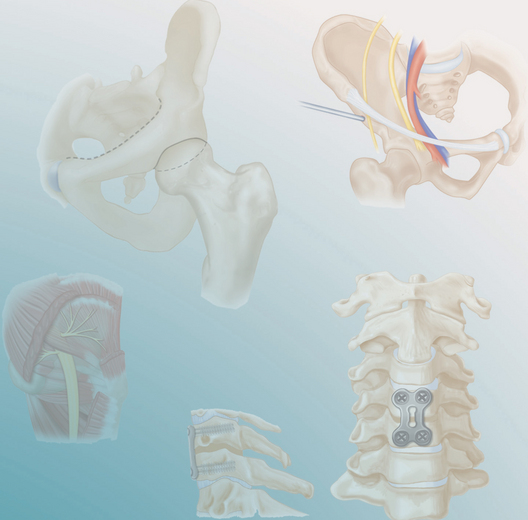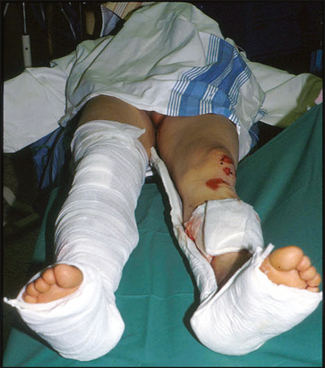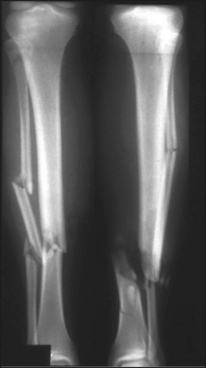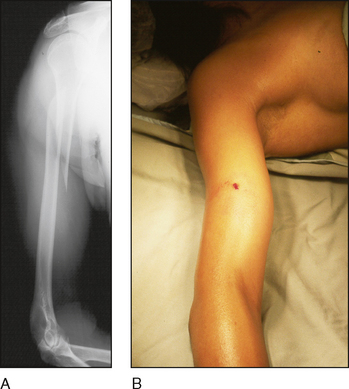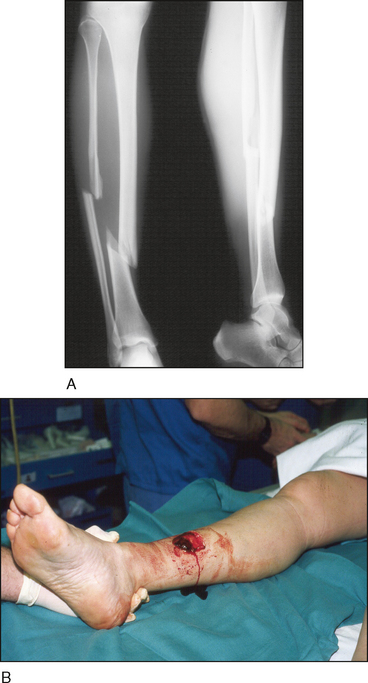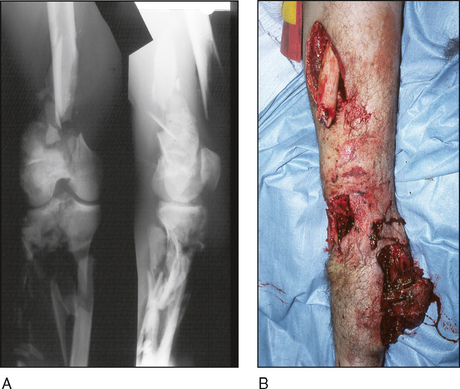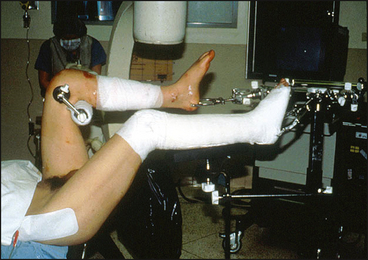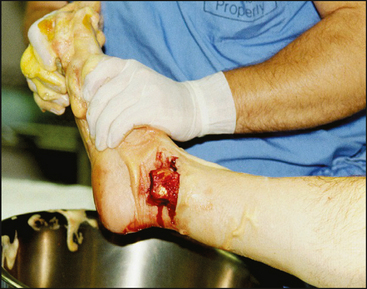PROCEDURE 48 Treatment of Open Fractures
Examination/Imaging
 Emergency management
Emergency management• Emergency treatment must be initiated as soon as possible. This includes intravenous antibiotic treatment, tetanus prophylaxis, sterile dressings, and splinting of the limb (Fig. 1).
 Standard radiographs (anteroposterior, lateral) of affected limb(s) should be obtained to plan operative stabilization of the injury (Fig. 2).
Standard radiographs (anteroposterior, lateral) of affected limb(s) should be obtained to plan operative stabilization of the injury (Fig. 2).• Ideally, the patient should be positioned only once to allow for both irrigation and débridement of the wound and stabilization procedures.
Surgical Anatomy
 The surgeon needs to be familiar with the local anatomy in the fracture area in order to protect all neurovascular structures.
The surgeon needs to be familiar with the local anatomy in the fracture area in order to protect all neurovascular structures.• The surgeon needs to plan for use of a fracture table or radiolucent table as required. Any fluoroscopy equipment needs to be arranged appropriately in the room before the start of the procedure (see Fig. 6).
Positioning
 Patient positioning should be determined by the location of the open wound and location of the fracture. Most patients can be positioned supine.
Patient positioning should be determined by the location of the open wound and location of the fracture. Most patients can be positioned supine.• Timing of surgical treatment
 Two studies have shown a decreased infection rate when the initial débridement is performed within 6 hours after injury.
Two studies have shown a decreased infection rate when the initial débridement is performed within 6 hours after injury.
 However, several studies have not shown any significant difference in infection rates when comparing early débridement (within 6 hours) to later débridement (after 6 hours). Ideally, the patient should be brought to the operating room as soon as possible.
However, several studies have not shown any significant difference in infection rates when comparing early débridement (within 6 hours) to later débridement (after 6 hours). Ideally, the patient should be brought to the operating room as soon as possible.
 Two studies have shown a decreased infection rate when the initial débridement is performed within 6 hours after injury.
Two studies have shown a decreased infection rate when the initial débridement is performed within 6 hours after injury. However, several studies have not shown any significant difference in infection rates when comparing early débridement (within 6 hours) to later débridement (after 6 hours). Ideally, the patient should be brought to the operating room as soon as possible.
However, several studies have not shown any significant difference in infection rates when comparing early débridement (within 6 hours) to later débridement (after 6 hours). Ideally, the patient should be brought to the operating room as soon as possible.Procedure
STEP 1: DÉBRIDEMENT
 Prior to formal prepping and draping of the limb, a “prescrub” can be useful to remove gross contamination from the wound and skin (Fig. 7).
Prior to formal prepping and draping of the limb, a “prescrub” can be useful to remove gross contamination from the wound and skin (Fig. 7). The open wound should be extended proximally and distally until healthy tissue is visualized (Fig. 8). An attempt should be made to incorporate the extension of the wound into the definitive approach for the ultimate surgical exposure.
The open wound should be extended proximally and distally until healthy tissue is visualized (Fig. 8). An attempt should be made to incorporate the extension of the wound into the definitive approach for the ultimate surgical exposure. The full extent of the injury needs to be visualized to allow a thorough débridement.
The full extent of the injury needs to be visualized to allow a thorough débridement.• Damaged or devitalized skin edges must be sharply excised to leave a clean and viable skin edge (Fig. 9A).
 When performing the débridement, one should avoid distally based flaps and leave the smallest skin flaps whenever possible.
When performing the débridement, one should avoid distally based flaps and leave the smallest skin flaps whenever possible. Only the minimum skin required for a thorough débridement should be excised in order to plan for future definitive wound closure. However, when in doubt, any tissue that looks suspicious should be excised.
Only the minimum skin required for a thorough débridement should be excised in order to plan for future definitive wound closure. However, when in doubt, any tissue that looks suspicious should be excised.Stay updated, free articles. Join our Telegram channel

Full access? Get Clinical Tree


